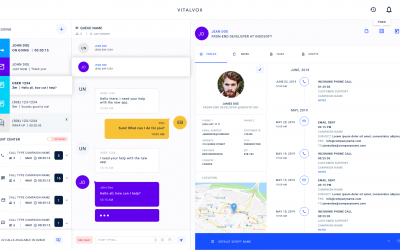
As the demand for seamless and scalable communication continues to grow, Asterisk powers VoIP systems with unmatched flexibility and reliability. Even in 2026, it remains the core engine behind many business VoIP solutions. So, what keeps Asterisk at the forefront after more than two decades? The answer lies in its adaptability, affordability, and ongoing innovation.
Let’s dive into why Asterisk remains the trusted choice for modern business communications.
What Is Asterisk and Why Does It Matter Today?
At its core, Asterisk is an open-source communications framework that lets businesses create tailored VoIP systems. First released in 1999, Asterisk has matured into a powerful platform used to build everything from small PBX systems to enterprise-grade contact centers.
Unlike proprietary systems, Asterisk allows full customization. Therefore, businesses can create voice applications that meet their exact needs—without being boxed in by rigid vendor limitations.
Even more importantly, it eliminates licensing costs, which continues to make it an appealing option in today’s cost-conscious environment.
Flexibility That Aligns With Business Demands
Today’s business environment requires communication systems that can evolve. Fortunately, Asterisk’s modular design makes this possible. Organizations can add features like call queues, auto-attendants, or conferencing as they grow, without needing a complete overhaul.
Furthermore, Asterisk supports numerous protocols such as SIP, IAX, and WebRTC. This ensures compatibility with both existing legacy systems and modern cloud-based tools. As a result, it serves as a flexible bridge between traditional telephony and cutting-edge VoIP infrastructure.
Scalability That Supports Long-Term Growth
As businesses expand, communication needs inevitably become more complex. Luckily, Asterisk is built to scale. Whether supporting a startup with ten users or an enterprise with thousands of concurrent calls, it adapts to different workloads without sacrificing performance.
Moreover, advancements in cloud hosting and containerization have made it easier to deploy Asterisk in distributed environments. This means organizations can scale across locations while maintaining centralized management and control.
Security and Reliability Built for 2026
Cybersecurity is more critical than ever. Thankfully, Asterisk benefits from an active global community that continually identifies and patches vulnerabilities. This ongoing support helps ensure the system remains secure even as threats evolve.
Additionally, businesses can implement advanced failover configurations, real-time monitoring, and redundancy protocols with Asterisk. These features significantly reduce the risk of downtime and ensure continuous service availability.
A Community That Fuels Constant Innovation
Open-source success often hinges on its community, and Asterisk is no exception. Thousands of contributors worldwide help shape its roadmap, add new features, and resolve issues quickly. As a result, Asterisk remains not only relevant but also forward-thinking.
On top of that, commercial support options provided by companies like Sangoma offer businesses the reliability of professional assistance without losing the flexibility of open-source.
Why Asterisk Still Leads the Pack in 2026
In a world increasingly defined by unified communications, cloud telephony, and remote work, Asterisk powers VoIP systems that are customizable, affordable, and highly adaptable. While many platforms force businesses into pre-defined solutions, Asterisk empowers them to design systems around their own operational goals.
Ultimately, its open nature, low total cost of ownership, and ability to integrate with both old and new technologies make Asterisk a smart investment—even in 2026.
Contact Us
Looking to modernize your VoIP system with a scalable, secure solution? Our experts specialize in building custom Asterisk-powered systems tailored to your specific needs.
Contact our team and discover how Asterisk can elevate your communication infrastructure while reducing operational costs.
FAQs: Everything You Need to Know About Asterisk in 2026
1. Is Asterisk still relevant for enterprise-level VoIP systems?
Yes. Asterisk remains highly relevant in 2026 due to its scalability, security, and integration capabilities with modern technologies like WebRTC and cloud platforms.
2. Does using Asterisk mean sacrificing support or stability?
Not at all. While Asterisk is open-source, it benefits from both a strong developer community and commercial support options that ensure enterprise-level reliability.
3. Can Asterisk integrate with cloud-based tools and CRMs?
Absolutely. Asterisk is designed to integrate with a wide range of APIs and platforms, including CRMs, helpdesk software, and cloud PBX solutions.
4. Is Asterisk secure enough for industries like healthcare or finance?
Yes. With proper configuration and regular updates, Asterisk can meet strict compliance requirements, including HIPAA and PCI standards.
5. What’s the learning curve like for IT teams new to Asterisk?
While there is a learning curve, extensive documentation and community support make it accessible. Additionally, many companies offer managed Asterisk services to simplify deployment and management.
Categories
- Agent Performance & Training
- AI solutions
- Asterisk
- Business Growth
- Call Center Performance & Productivity
- Call Center Software Platform
- Call Center Technology & AI Integration
- Call Center Training
- Call Center Workforce Management
- Call Monitoring
- Cloud-Based Solutions
- Customer Experience
- Data Security
- General
- Insights
- Integrated Customer Service
- News
- Omnichannel Communication Strategy
- Omnichannel Support
- Quality Assurance
- Tech


